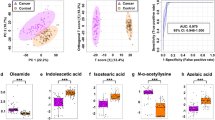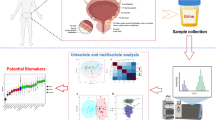Abstract
Purpose
Bladder cancer (BC) is among the most frequent malignancies worldwide. Novel non-invasive markers are needed to diagnose and stage BC with more accuracy than invasive procedures like cystoscopy. To date, no study has identified urine metabolites characteristic of all BC stages. To discover novel urine metabolomic profiles to diagnose and stage non-muscle-invasive (NMIBC) and muscle-invasive (MIBC) patients using mass spectrometry-based metabolomics.
Methods
We prospectively recruited 198 BC patients and 98 age- and sex-matched healthy volunteers without evidence of renal or bladder condition confirmed by ultrasound, from whom we collected a first morning urine sample (before surgery in patients). In a discovery stage, an untargeted metabolomic analysis was conducted in urine samples of a selection of 64 BC patients (19 TaG1, 11 TaG3, 20 T1G3, 12 T2G3, 1 T2G2, 1 T3G3) and 20 controls to identify dysregulated metabolites. Next, after exhaustive multivariate analysis, confirmed dysregulated metabolites were validated in an independent cohort of 134 BC patients (19 TaG1, 62 TaG2, 9 TaG3, 15 T1G2, 16 T1G3, 4 T2G2, 9 T2G3) and 78 controls.
Results
We validated p-cresol glucuronide as potential diagnostic biomarker for BC patients compared to controls (AUC = 0.79). For NMIBC, p-cresol glucuronide was valuable as staging biomarker (AUC = 0.803). And among NMIBCs, p-coumaric acid may be a potential specific staging biomarker for the TaG1 NMIBC; however, future validation experiments should be conducted once the precise version of the standard is commercially available. Remarkably, for MIBC we validated spermine as potential specific staging biomarker (AUC = 0.882).
Conclusion
Ours is the first metabolomics study conducted in urine of a thoroughly characterized cohort comprising all stages of NMIBC, MIBC and healthy controls in which we identified non-invasive diagnostic and staging biomarkers. These may improve BC management, thus reducing the use of current harmful diagnostic techniques.
Graphic abstract





Similar content being viewed by others
References
Siegel RL, Miller KD, Jemal A (2019) Cancer statistics, 2019. CA Cancer J Clin 69:7–34. https://doi.org/10.3322/caac.21551
Sung H, Ferlay J, Siegel RL et al (2021) Global cancer statistics 2020: Globocan estimates of incidence and mortality worldwide for 36 cancers in 185 countries. CA Cancer J Clin 71:209–249. https://doi.org/10.3322/caac.21660
Svatek RS, Hollenbeck BK, Holmang S et al (2014) The economics of bladder cancer: costs and considerations of caring for this disease. Eur Urol 66:253–262. https://doi.org/10.1016/j.eururo.2014.01.006
Cumberbatch MGK, Noon AP (2019) Epidemiology, aetiology and screening of bladder cancer. Transl Androl Urol 8:5–11. https://doi.org/10.21037/tau.2018.09.11
Zhu CZ, Ting HN, Ng KH, Ong TA (2019) A review on the accuracy of bladder cancer detection methods. J Cancer 10:4038–4044. https://doi.org/10.7150/jca.28989
Faiena I, Rosser CJ, Chamie K, Furuya H (2019) Diagnostic biomarkers in non-muscle invasive bladder cancer. World J Urol 37:2009–2016. https://doi.org/10.1007/s00345-018-2567-1
Lee HH, Kim SH (2020) Review of non-invasive urinary biomarkers in bladder cancer. Transl Cancer Res 9:6554–6564. https://doi.org/10.21037/tcr-20-1990
Laukhtina E, Shim SR, Mori K et al (2021) Diagnostic accuracy of novel urinary biomarker tests in non-muscle-invasive bladder cancer: a systematic review and network meta-analysis. Eur Urol Oncol 4:927–942. https://doi.org/10.1016/j.euo.2021.10.003
Pasikanti KK, Esuvaranathan K, Ho PC et al (2010) Noninvasive urinary metabonomic diagnosis of human bladder cancer. J Proteome Res 9:2988–2995. https://doi.org/10.1021/pr901173v
Srivastava S, Roy R, Singh S et al (2010) Taurine—a possible fingerprint biomarker in non-muscle invasive bladder cancer: a pilot study by 1h NMR spectroscopy. Cancer Biomark 6:11–20. https://doi.org/10.3233/CBM-2009-0115
Peng J, Chen YT, Chen CL, Li L (2014) Development of a universal metabolome-standard method for long-term LC-MS metabolome profiling and its application for bladder cancer urine-metabolite-biomarker discovery. Anal Chem 86:6540–6547. https://doi.org/10.1021/ac5011684
Wittmann BM, Stirdivant SM, Mitchell MW et al (2014) Bladder cancer biomarker discovery using global metabolomic profiling of urine. PLoS ONE 9:e115870. https://doi.org/10.1371/journal.pone.0115870
Shen C, Sun Z, Chen D et al (2015) Developing urinary metabolomic signatures as early bladder cancer diagnostic markers. OMICS 19:1–11. https://doi.org/10.1089/omi.2014.0116
Shao CH, Chen CL, Lin JY, et al. (2017) Metabolite marker discovery for the detection of bladder cancer by comparative metabolomics. Oncotarget 8:38802–38810. https://doi.org/10.18632/oncotarget.16393
Cheng X, Liu X, Liu X et al (2018) Metabolomics of non-muscle invasive bladder cancer: biomarkers for early detection of bladder cancer. Front Oncol 8:494. https://doi.org/10.3389/fonc.2018.00494
Loras A, Trassierra M, Sanjuan-Herraez D et al (2018) Bladder cancer recurrence surveillance by urine metabolomics analysis. Sci Rep 8:9172. https://doi.org/10.1038/s41598-018-27538-3
Liu X, Cheng X, Liu X et al (2018) Investigation of the urinary metabolic variations and the application in bladder cancer biomarker discovery. Int J Cancer 143:408–418. https://doi.org/10.1002/ijc.31323
Bansal N, Gupta A, Mitash N et al (2013) Low- and high-grade bladder cancer determination via human serum-based metabolomics approach. J Proteome Res 12:5839–5850. https://doi.org/10.1021/pr400859w
Tan G, Wang H, Yuan J et al (2017) Three serum metabolite signatures for diagnosing low-grade and high-grade bladder cancer. Sci Rep 7:46176. https://doi.org/10.1038/srep46176
Zhou Y, Song R, Zhang Z et al (2016) The development of plasma pseudotargeted GC-MS metabolic profiling and its application in bladder cancer. Anal Bioanal Chem 408:6741–6749. https://doi.org/10.1007/s00216-016-9797-0
Tripathi P, Somashekar BS, Ponnusamy M et al (2013) HR-MAS NMR tissue metabolomic signatures cross-validated by mass spectrometry distinguish bladder cancer from benign disease. J Proteome Res 12:3519–3528. https://doi.org/10.1021/pr4004135
Oto J, Fernandez-Pardo A, Roca M et al (2020) Urine metabolomic analysis in clear cell and papillary renal cell carcinoma: a pilot study. J Proteomics 218:103723. https://doi.org/10.1016/j.jprot.2020.103723
Piovesana S, Capriotti AL, Cerrato A et al (2019) Graphitized carbon black enrichment and UHPLC-MS/MS allow to meet the challenge of small chain peptidomics in urine. Anal Chem 91:11474–11481. https://doi.org/10.1021/acs.analchem.9b03034
Zheng J, Zhang L, Johnson M, Mandal R, Wishart DS (2020) Comprehensive targeted metabolomic assay for urine analysis. Anal Chem 92:10627–10634. https://doi.org/10.1021/acs.analchem.0c01682
Meyer TW, Hostetter TH (2012) Uremic solutes from colon microbes. Kidney Int 81:949–954. https://doi.org/10.1038/ki.2011.504
Schmidt MA, Meydan C, Schmidt CM, Afshinnekoo E, Mason CE (2020) Elevation of gut-derived p-cresol during spaceflight and its effect on drug metabolism and performance in astronauts. bioRxiv. doi: https://doi.org/10.1101/2020.11.10.374645
Mutsaers HA, Caetano-Pinto P, Seegers AE et al (2015) Proximal tubular efflux transporters involved in renal excretion of p-cresyl sulfate and p-cresyl glucuronide: implications for chronic kidney disease pathophysiology. Toxicol In Vitro 29:1868–1877. https://doi.org/10.1016/j.tiv.2015.07.020
Pasikanti KK, Esuvaranathan K, Hong Y et al (2013) Urinary metabotyping of bladder cancer using two-dimensional gas chromatography time-of-flight mass spectrometry. J Proteome Res 12:3865–3873. https://doi.org/10.1021/pr4000448
Sanders JM, Bucher JR, Peckham JC, Kissling GE, Hejtmancik MR, Chhabra RS (2009) Carcinogenesis studies of cresols in rats and mice. Toxicology 257:33–39. https://doi.org/10.1016/j.tox.2008.12.005
Lawrie CA, Renwick AG, Sims J (1985) The urinary excretion of bacterial amino-acid metabolites by rats fed saccharin in the diet. Food Chem Toxicol 23:445–450. https://doi.org/10.1016/0278-6915(85)90138-3
Fujita K, Nagatsu T, Maruta K, Ito M, Senba H (1976) Urinary putrescine, spermidine, and spermine in human blood and solid cancers and in an experimental gastric tumor of rats. Cancer Res 36:1320–1324
Hao L, Johnson J, Lietz CB et al (2017) Mass defect-based n, n-dimethyl leucine labels for quantitative proteomics and amine metabolomics of pancreatic cancer cells. Anal Chem 89:1138–1146. https://doi.org/10.1021/acs.analchem.6b03482
Durie BG, Salmon SE, Russell DH (1977) Polyamines as markers of response and disease activity in cancer chemotherapy. Cancer Res 37:214–221
Sanford EJ, Drago JR, Rohner TJ, Kessler GF, Sheehan L, Lipton A (1975) Preliminary evaluation of urinary polyamines in the diagnosis of genitourinary tract malignancy. J Urol 113:218–221. https://doi.org/10.1016/s0022-5347(17)59448-3
Roszell JA, Douglas CJ, Irving CC (1977) Polyamine-stimulated growth of cultured rat urinary bladder epithelial cells. Cancer Res 37:239–243
Babbar N, Gerner EW (2011) Targeting polyamines and inflammation for cancer prevention. Recent Results Cancer Res 188:49–64. https://doi.org/10.1007/978-3-642-10858-7_4
Sharma A, Glaves D, Porter CW, Raghavan D, Bernacki RJ (1997) Antitumor efficacy of n1,n11-diethylnorspermine on a human bladder tumor xenograft in nude athymic mice. Clin Cancer Res 3:1239–1244
Weeks RS, Vanderwerf SM, Carlson CL et al (2000) Novel lysine-spermine conjugate inhibits polyamine transport and inhibits cell growth when given with dfmo. Exp Cell Res 261:293–302. https://doi.org/10.1006/excr.2000.5033
Soda K (2011) The mechanisms by which polyamines accelerate tumor spread. J Exp Clin Cancer Res 30:95. https://doi.org/10.1186/1756-9966-30-95
Sud M, Fahy E, Cotter D et al (2016) Metabolomics workbench: An international repository for metabolomics data and metadata, metabolite standards, protocols, tutorials and training, and analysis tools. Nucleic Acids Res 44:D463-470. https://doi.org/10.1093/nar/gkv1042
Acknowledgements
The MS metabolomics data have been deposited to the Metabolomics Workbench [40] public repository (www.metabolomicsworkbench.org/) with the data set identifier ST001662. We would like to thank Dr. Francisco España for his extraordinary guidance and supervision.
Funding
This research was supported by research grants from Instituto de Salud Carlos III (PI17/00495, PI20/00075, FI21/00171), FEDER una manera de hacer Europa, Generalitat Valenciana (ACIF/2017/138) and Sociedad Española de Trombosis y Hemostasia. All these are nonprofit organizations, and therefore are not involved in experimental/clinical work, data analyses, and preparation of the manuscript.
Author information
Authors and Affiliations
Contributions
JO: protocol development, data collection, data analysis and manuscript writing. ÁFP: data analysis. MR: protocol development, data analysis, and manuscript writing. EP: manuscript editing and supervision. FC: protocol development. RH: data analysis. JPA: resources. CDVD: resources and manuscript editing. MMS: resources and manuscript editing. PM: project development, management, data analysis, manuscript writing and funding acquisition. All authors read and approved the final manuscript.
Corresponding author
Ethics declarations
Conflict of interest
The authors declare that they have no known competing financial interests or personal relationships that could have appeared to influence the work reported in this paper.
Ethical approval and consent to participate
Informed consent was obtained from all participants according to protocols approved by the ethics review board at La Fe University and Polytechnic Hospital. The study was performed according to the declaration of Helsinki, as amended in Edinburgh in 2000.
Additional information
Publisher's Note
Springer Nature remains neutral with regard to jurisdictional claims in published maps and institutional affiliations.
Supplementary Information
Below is the link to the electronic supplementary material.
Rights and permissions
Springer Nature or its licensor holds exclusive rights to this article under a publishing agreement with the author(s) or other rightsholder(s); author self-archiving of the accepted manuscript version of this article is solely governed by the terms of such publishing agreement and applicable law.
About this article
Cite this article
Oto, J., Fernández-Pardo, Á., Roca, M. et al. LC–MS metabolomics of urine reveals distinct profiles for non-muscle-invasive and muscle-invasive bladder cancer. World J Urol 40, 2387–2398 (2022). https://doi.org/10.1007/s00345-022-04136-7
Received:
Accepted:
Published:
Issue Date:
DOI: https://doi.org/10.1007/s00345-022-04136-7




